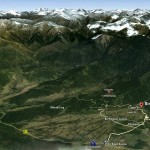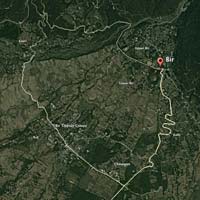The greater Bir area is a constellation of smaller villages at the western edge of the Kangra District of Himachal Pradesh. For the first-time visitor, the question of which part of this area is actually ‘Bir’ can be a bit confusing, since different populations use the name to refer to slightly different areas. The virtual tour below (courtesy of Dharmalaya), will help you get your bearings.
Orientation to the Greater Bir Area
There are several neighbouring villages that are often referred to collectively as ‘Bir’ (especially by people who aren’t from the Bir area, but by some locals as well), including Bir proper, Chowgan (home of the Bir Tibetan Colony), ‘Bir Road’ market, and as well as the surrounding villages of Billing, Bhattu (Sherab Ling), Keori, Gunher, and a few other hamlets. For clarity, we will refer to the larger area as ‘the Bir area’ or ‘greater Bir’ and to the village of Bir itself as ‘Bir proper’.
BIR PROPER (UPPER & LOWER BIR)
The original settlement of Bir (established circa 1600 C.E.) sits at the northern edge of the constellation of villages forming the greater Bir area (in what is now called ‘Upper Bir’), perched at the top of the gentle slopes of the Himalayan foothills, just before the earth turns sharply up toward the snow peaks. It is a quiet Indian village with most of its buildings clustered along the main Bir-Billing road. The heart of Bir proper is the Bir bazaar, a quiet market with only a few dozen shops. At the south end of Bir bazar is the bus stand and a large tea processing factory, which offers tours for those interested in a fine orthodox cuppa.
People from Chowgan and the Tibetan Colony may refer to all of Bir proper (including both Lower and Upper Bir) as ‘Upper Bir’ but, according to the residents of Bir proper, ‘Upper Bir’ refers to everything above the bazaar, while ‘Lower Bir’ refers to the area below the bazaar but above Chowgan and the Tibetan Colony. (Note: To get to Bir proper from elsewhere in the area, you may need to specify ‘Upper Bir’. If you simply say ‘Bir’ to a taxi driver, for example, he may assume you want to go to the Bir Tibetan Colony since that’s the main tourist centre of the Bir area.)
Chowgan (also spelled ‘chaugan’)
Chowgan village is essentially a sprawling ‘suburb’ to the south of Lower Bir. It was settled more recently than Bir proper and has a different flavour. Most of its residents were farmers or government employees until the current generation of young adults got other ideas. It’s best-known feature is the Tibetan Colony (below), but the rest of Chowgan village is quieter, cleaner, and well worth exploring on foot on bicycle.
BIR TIBETAN COLONY (A.K.A. SIMPLY ‘COLONY’)
Located at the western extreme of Chowgan village, southwest of Bir proper, the Bir Tibetan Colony is one of the earliest Tibetan refugee settlements in India, established in 1962 by refugees from the Kham region of Eastern Tibet. The ‘Colony’, as it is called locally, features several Buddhist monasteries and temples and a large stupa. One of the main attractions for students and long-term visitors is the Deer Park Institute, which hosts a variety of quality lectures, courses, and practice programmes in the Indian wisdom traditions and other subjects. The Colony is also of interest to visitors as the main centre of accommodation in the Bir area, with several guest houses and a sampling of quirky cafés frequented by travellers and Tibetan refugees. (See our Bir Beds page for information on accommodation in the Bir area.)
BILLING: PARAGLIDING PARADISE
Bir is also the staging ground for what is regarded as the world’s second best paragliding launch site: the tiny hamlet of Billing, just a few kilometers above Bir. Hundreds of pilots from across the globe come to Bir every spring and autumn to paraglide over the mountains and tea plantations of Bir and the Dhauladhar Range of the Himalayas. Lessons and tandem flights are available for beginners (but be warned that paragliding is a sport with inherent risks: injuries are not uncommon and there have been a few deaths over the years).
BIR ROAD BAZAAR: A NOISY JUNCTION MARKET ON THE WAY TO BIR
The first corner of Bir most visitors will see is the highway junction market known locally simply as ‘Bir Road’, at the well-signposted turnoff to Bir from the NH20 (the national highway running between Kangra and Mandi). This noisy cluster of shops is the best place in the immediate Bir area to shop for provisions (in terms of price and selection), with a good hardware store and a couple of veggie vendors with good selections of greens (not always available further up the hill). (Note that the name ‘Bir Road’ can refer to two different things: the Bir Road market specifically, or the whole stretch of road that connects the NH20 with the village of Bir to the north. If you need to specify the former, say ‘Bir Road Bazaar’ and, for the latter, say ‘Main Bir Road’.)
BHATTU: HOME OF PALPUNG SHERAB LING MONASTERY
Just a few kilometers west of Bir is Upper Bhattu, more widely known by the name of its landmark, Sherab Ling, a sprawling Tibetan Buddhist monastery and retreat complex. Sherab Ling serves as the exile seat of the 12th Chamgon Kenting Tai Situpa, one of the regents of the Karmapa and the Karma Kagyü lineage of Tibetan Buddhism. Sherab Ling periodically hosts courses in Buddhist meditation and philosophy. Accommodation is available at the Sherab Ling Guest House except at peak times (when you can easily stay in the Tibetan Colony; it’s a lovely one-hour walk, a reasonably level bike ride or a quick taxi hop).



You must be logged in to post a comment.